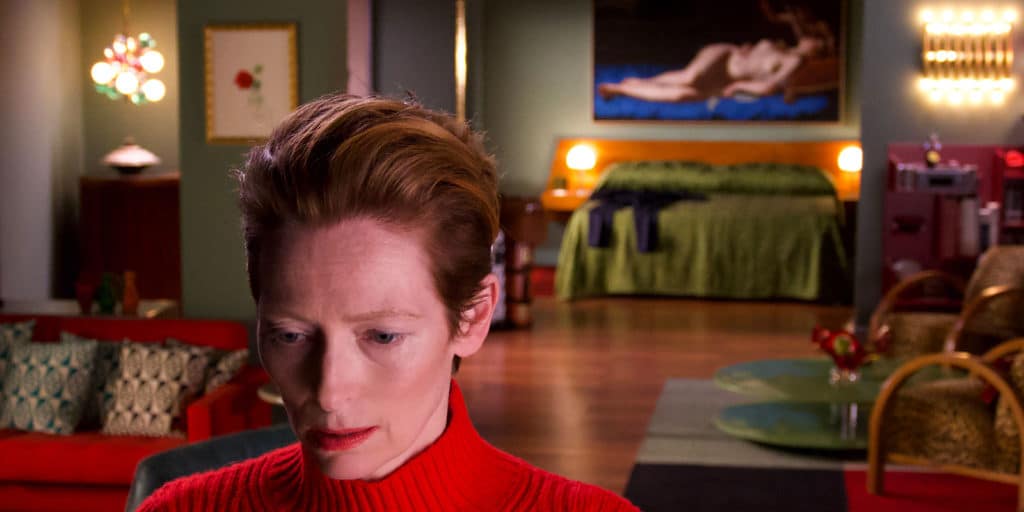Pedro Almodóvar’s first English film “The Human Voice,” starring Tilda Swinton, opens nationwide on Friday, March 12, 2021. The short film screens in New York City at Film Forum in Hudson Square on Friday, April 2, 2021. Tickets are on sale through Thursday, April 29, 2021 extended to Thursday, May 13, 2021.
Synopsis
This is Almodóvar’s own synopsis.
A woman watches time passing next to the suitcases of her ex-lover (who is supposed to come pick them up, but never arrives) and a restless dog who doesn’t understand that his master has abandoned him. Two living beings facing abandonment. During the three days of waiting, the woman only goes out to the street once, to buy an axe and a can of gasoline.
The woman goes through all sorts of moods, from helplessness to despair and loss of control. She makes herself up, she dresses up as if going to a party, she considers throwing herself off of the balcony, until her ex-lover calls on the phone, but she’s unconscious because she’s taken a combination of thirteen pills and cannot answer the call. The dog licks her face until she wakes up. After a cold shower, revived by a coffee as black as her state of mind, the telephone rings again and this time she can answer.
The human voice is hers, we never hear the voice of her lover. At first she pretends to act normal and calm, but she is always on the verge of exploding in the face of the man’s hypocrisy and meanness. “The Human Voice” is a moral lesson about desire, even though its protagonist is on the verge of the very same abyss. Risk is an essential part of the adventure of living and loving. Pain is very present in the monologue. As I said at first, it is about the disorientation and distress of two living beings who grieve their master.
— Pedro Almodóvar
Loss and More Loss
All the lessons of this moment in history are about loss. In the COVID-19 pandemic, we are losing family and loved ones, jobs and investments, and most precious of all – human contact.
Being humans, most of us respond in similar ways, alternating between steeled fury and leaps into the abyss.
The ways actress Tilda Swinton expresses her feelings of loss are so like the ways many of us are dealing with the pandemic. We wait calmly, get all dressed up for nothing, and sometimes we just rage. Most of the film is shot in her apartment, so the protagonist is caged in four walls just like we have been locked inside.
It’s interesting to watch a dog whose character is pure love and the woman whose more complex character is both love and hate. There’s the one trip out of the house to the hardware store, as if we could just buy something to make it all right.
Though we may be dying for contact, in the end, the conversation we most need is not external at all. It’s a honest conversation with ourselves.
Art With a Mind of Its Own
The film opened in September 2020 at the Venice International Film Festival and then the New York Film Festival. It opened in Spain that October.
It’s convenient to assume the filmmaker is commenting on the pandemic, but given the long lead time required to make a film, this is yet another example of great art arriving at the right time – almost as if by its own choosing.
La Voix humaine
French theater legend Jean Cocteau wrote the play in 1928. It’s entirely about a woman on the phone with her ex-lover who is about to be married.
The human voice is a reference to the the Vox Humana, a setting in old organs that mimics the human voice. In loss, it’s what you hear in your head and what you dream of hearing for real.
Pedro Almodóvar
Almodóvar came up as part of La Movida Madrileña, the renaissance of Spanish identity after the death of dictator Francisco Franco in 1975.
It was a wild time (in New York City too!) and the identity the Spaniards recovered was one of having fun. Everything was mod with bright colors and while some of us don’t remember much, we all had a great time.
You see this in Almodóvar’s work. He turns kitsch into high art. Every scene looks like a painting filled with endless detail. His scenes can be like fractal graphics (computer graphics of nature) where the level of detail remains constant no matter how close or far you zoom. For those of a certain age, even the colors are memories.
On top of this fun attention to detail, Almodóvar throws a bundle of emotional energy. He is famous for his portrayals of women. In fact, he seems to know women almost better than women know themselves.
Almodóvar already worked this theme. His breakthrough work “Women on the Verge of a Nervous Breakdown (1988) was also based on “La Voix humaine.”

